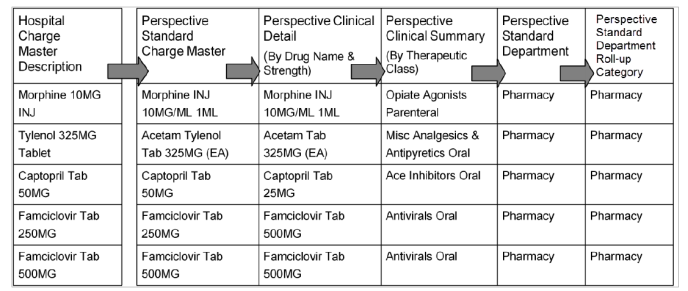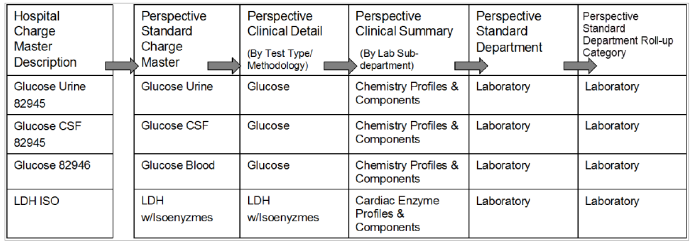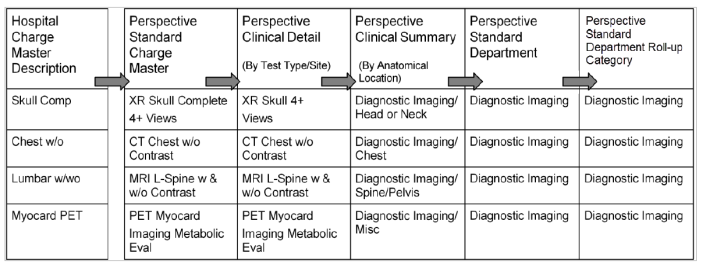Detailed Mapping Philosophy for Key Departments
Mapping philosophy refers to the manner in which elements in one reporting level are grouped into a singular category in the next higher reporting level. Premier’s SPL provides four Comparative Reporting Levels (Hierarchies). The first level, the Perspective Standard Department, represents a hospital’s most common cost centers. The examples in this section illustrate the mapping philosophy in detail.
Mapping Example 1: Pharmacy
The Perspective Standard Department Pharmacy includes approximately 469 Clinical Summary and over 4,962 Clinical Detail mapped resource consumption line-item descriptions. The Perspective Clinical Summary breaks out each pharmaceutical by therapeutic class, while the Perspective Clinical Detail further breaks out each therapeutic class by its drug name and strengths.
The chart below depicts several actual mapping examples.
- First, each hospital’s pharmaceuticals are mapped to the Perspective Standard Charge Master.
- Then, the Perspective Standard Charge Master line items are successively mapped to each higher Comparative Reporting Level (Hierarchy).

Mapping Example 2: Central Supply
The Perspective Standard Department Central Supply includes approximately 21 Clinical Summary and almost 4,773 Clinical Detail mapped resource line-item descriptions. The Perspective Clinical Summary breaks out each supply item by department/function, while the Perspective Clinical Detail further breaks out each department/function item by supply item description.
The chart below depicts several actual mapping examples.
- First, each hospital’s pharmaceuticals are mapped to the Perspective Standard Charge Master.
- Then, the Perspective Standard Charge Master line items are successively mapped to each higher Comparative Reporting Level (Hierarchy).

Mapping Example 3: Laboratory
The Perspective Standard Department Laboratory includes approximately 15 Clinical Summary and over 1,492 Clinical Detail mapped resource consumption line-item descriptions. The Perspective Clinical Summary breaks out each laboratory item by lab sub-department, while the Perspective Clinical Detail further breaks out each lab department by test type/methodology.
The chart below depicts several actual mapping examples.
- First, each hospital’s pharmaceuticals are mapped to the Perspective Standard Charge Master.
- Then, the Perspective Standard Charge Master line items are successively mapped to each higher Comparative Reporting Level (Hierarchy).

Mapping Example 4: Diagnostic Imaging
The Perspective Standard Department Diagnostic Imaging includes Diagnostic Radiology, CT, and MRI. The standard department includes approximately 17 Clinical Summary and 583 Clinical Detail mapped resource consumption line- item descriptions. The Perspective Clinical Summary breaks out each diagnostic imaging item by anatomical location, while the Perspective Clinical Detail further breaks out each anatomical location by test type/site.
The chart below depicts several actual mapping examples.
- First, each hospital’s pharmaceuticals are mapped to the Perspective Standard Charge Master.
- Then, the Perspective Standard Charge Master line items are successively mapped to each higher Comparative Reporting Level (Hierarchy).
